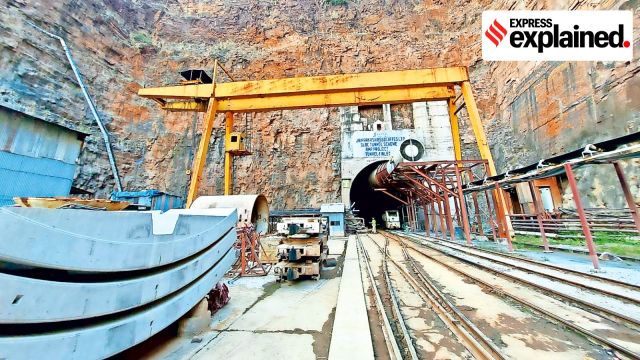Around 5:30 am on November 12, 2023, an under-construction tunnel on the Yamunotri National Highway, connecting Silkyara and Dandalgaon in Uttarakhand’s Uttarkashi district, collapsed, trapping 41 workers inside.
Rescuers could establish communication with the men through walkie-talkies, and food and oxygen were supplied through a pipe meant to supply water. After over 400 hours, they were rescued.

On Saturday, another tunnel collapse was reported, trapping eight men, this time in Telangana, but experts say this is a more challenging operation.
With operations underway at the Srisailam Left Bank Canal (SLBC) tunnel in Nagarkurnool, The Indian Express spoke with experts to understand how the operations are different from that of Uttarakhand’s Silkyara tunnel rescue.
The water challenge
National Disaster Response Force Tenth Battalion Commandant N Prasanna Kumar, who is coordinating rescue efforts in Telangana with the Army, Navy, and other agencies, said that the primary challenge and the difference between the two incidents is that in Silkyara, there was no water and mud seepage involved.
“In water, anyone can survive at best for 20 minutes. Had it been a dry area, those trapped could survive for at least five days. We are dealing with a thick wall of mud-water mix here,” he said.
“Another difference is workers trapped in Silkyara had a two-kilometre moving space inside the tunnel, but here, there is no such gap as they are in the dead end of the tunnel,” he said, adding that the situation is similar to the Tapovan incident from 2021. In that incident, a flood severely damaged the hydropower project on the Dhauli Ganga River in Chamoli’s Tapovan, leading to slush choking a part of the tunnel and trapping and killing over 200 people.
Story continues below this ad
No rat hole miners
A key set of rescuers in the Silkyara incident, rat hole miners, will not be practical in Telangana, said Kumar. “Rat hole miners only work in sand and dry areas, and here, in water, they cannot be useful. There is little technology to go through this wall of slush to reach the trapped men,” he said.
In the Silkyara rescue, when parts of the auger machine drilling through the debris broke inside the pipes meant to help people crawl through, excavators used gas torches to cut through steel. The machine, after digging some distance, halted again after its blades broke inside the pipe. Though the excavators cut the blades and cleared the steel with gas cutters, it generated heat and wore the rescuers out.
At this stage, the rat hole miners, known to employ a method of extracting coal from narrow, horizontal seams, went in to drill manually through the remaining 12 metres of debris. They pulled out the 41 men after almost a day of digging.
Difference in terrain
Speaking on condition of anonymity, one of the rescuers who led the operations in Uttarkashi said that the terrain is very different in both cases. “It was a type of loose rock in Silkyara. In Shivalik ranges, tunnels and underground structures are difficult to bore into and have more fragile geology. This took place 200 metres from the portal, making it easier to access, but it was difficult to dig through the debris of steel, rocks and boulders of 60 metres. The rock over the crown of the tunnel was 100 metres deep. In this case, where the hydro tunnel is being made, this distance is higher, making it impossible to dig from above,” he said.
Story continues below this ad
One of the most viable methods to use when there is debris in case of a collapse is the side drift method, he said. “But by the time we arrived, earth auger machines used to drill through soft soils were used. We had also initiated vertical drilling from the top in Silkyara, but horizontal drilling got us to the other side first. This is challenging in Telangana because the top surface is 400 metres high. Also, these rigs could damage the aquifers, and water could start pouring in, further endangering the trapped men,” said the official.









































